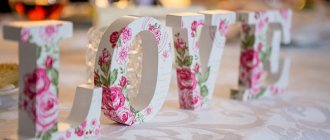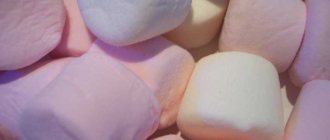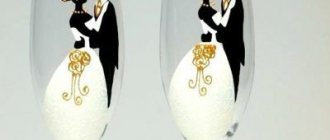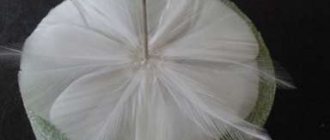Wedding accessories
- DIY boutonniere made of fresh flowers for the groom
- Wedding boutonniere made of satin ribbons for the groom
- Master class on corrugated paper boutonnieres
- How to make a wedding boutonniere from foamiran for the groom
Every couple in love wants their wedding to be perfect . But a perfect holiday requires great effort. You should carefully consider not only the menu and invitation cards, but also the outfit of the newlyweds. The boutonniere requires special attention - it must match the newlywed’s outfit and the bride’s dress. Making a wedding boutonniere for the groom with your own hands is not so difficult. You just need to be patient and time.
DIY boutonnieres for the groom
Where did the tradition come from?
The word “boutonniere” came into Russian from French; literally translated, it means “flower in the buttonhole.”
The attribute itself has been known since pagan times. Men attached a small bud to their wedding vestments before the ceremony, it was believed that this would scare away evil spirits. Different cultures believed that if this was not done, evil spirits could lead the groom astray from his chosen path, and the wedding would not take place. According to other beliefs, the absence of a boutonniere could provoke misfortune with the bride, so men strictly adhered to this tradition.
In the Middle Ages, the attribute began to be used by knights - by pinning a flower to their clothes on the side of the heart, they said that they were in love and faithful to their lady. At that time, only noble people wore boutonnieres; the miniature bouquet was made by servants. To keep it fresh longer, it was placed in a small flask with water and attached to clothing.
According to the established tradition, after the bride price, the groom gives his beloved a bouquet, and she, in turn, attaches a boutonniere to his suit. You can place it in the main flower arrangement in advance. Then, after the groom gives the bride a bouquet, she will take a flower from it and attach it to her future husband on the side of her heart as a sign of eternal love, as happened in Rome.
In the modern wedding tradition, a boutonniere is more of a tribute to tradition; no sacred meaning is attached to it. This attribute can be ordered from a florist or made by yourself. For this you can use both natural and artificial plants. Usually the bride is responsible for making a mini-bouquet, so the girl can use her imagination and create a unique composition.
Important! The groom should fasten the boutonniere on the left side of the pocket or lapel of his jacket. If the attribute is also made for guests, single men attach it to the left, married men to the right.
Boutonniere for the groom - tips and much more
Are you dreaming of the perfect wedding? But a perfect holiday requires maximum effort. You need to carefully consider the menu, invitations for guests, and attire for the newlyweds where the celebration will take place. The boutonniere for the groom deserves special attention. To successfully choose this accessory, you need to take into account the style of the bride’s outfit and many other subtleties.
Signs associated with the groom's boutonniere:
- A huge number of superstitions are associated with a wedding, and some signs affect the boutonniere for the groom:
- The flower must be attached on the left side, where the heart is located.
- Both young and young will need a safety pin, which is attached to clothing “head down” (to protect against the evil eye). A woman can attach it anywhere on the dress (only inside), and a man can attach an artificial or living flower to her. The most important thing is that the pin is not visible to strangers.
- While removing the veil from the betrothed, a couple of “young” guests are present - the girl puts on part of the young dress, and the man wears the groom’s boutonniere. If lovers are chosen for such a competition, they will soon get married.
- Young people should not part with either their veil or boutonniere. Therefore, before the start of the celebration, you will need to order an alternative flower and an attribute such as a boutonniere. These two things should be kept throughout the life of the family and act as an heirloom. For example, if a child in the family falls ill, they cover him with a veil or hang it over the bed to protect the baby from the evil eye.
When should the groom wear a boutonniere?
In almost all situations, the bride puts a boutonniere on the groom after the ransom has passed. The groom gives a bouquet, and the bride attaches a flower to her jacket as a sign of love. You can change this ancient tradition a little, which came to us from Rome. Place a boutonniere in the bride's bouquet so that she can give her future husband a flower from her bouquet, as they did before.
For witnesses
Types of accessories
During the period of preparation for the wedding, it is not necessary to purchase all the necessary wedding attributes in specialized stores or from private craftsmen; some accessories can be made with your own hands. Such details also include the groom's boutonniere - a flower that matches the bride's composition, which is attached to the pocket or lapel of the jacket. Recently, wedding flowers made from satin ribbons have become fashionable; any girl, even if she has not previously resorted to needlework, can make such an attribute with her own hands, spending a minimum of time.
As such, there is no division of boutonnieres into varieties; they can be roughly divided into living and artificial. A mini-wedding composition can also be classified according to style - if the celebration is thematic, then all the attributes must correspond to the general idea.
If earlier a separate large flower was used as a boutonniere, now there is another option - creating a real miniature bouquet from one main plant and several additional ones. A boutonniere for the groom made from fresh flowers can carry a deeper meaning, according to the language of flowers.
The following plants are commonly used:
- Rose. The most common flower for weddings. A white bud means innocence, a red boutonniere for the groom means passion, pink means the beginning of love, yellow means happiness and joy, and orange means intoxicating feelings.
- Peony. A boutonniere for the groom made of peonies, regardless of the shade, symbolizes love, beauty and protection. This is one of the noblest flowers in China; only noble people could grow it.
- Lily. A large bud symbolizes purity, wealth and prosperity in the family.
- Lilac. If the wedding takes place in the spring, lilac is one of the best options, since it is identified with the first and only love.
- Calla. Symbolizes love blessed by higher powers.
- Jasmine. In some countries, modesty and purity of love are attributed to this flower, in others it is believed that it symbolizes passion and ardor of feelings.
- Mistletoe. It has long been considered a symbol of lovers.
- Daisy. Symbolizes eternal pure love.
- Aster. Identified with grace, sincerity and love.
Depending on the style of the wedding, the boutonniere can be supplemented with other natural elements at your discretion. For example, cereal ears, bird feathers, wildflowers, twigs with berries, leaves or blades of grass of bizarre shapes are suitable.
A boutonniere made from artificial materials also has its advantages - it will not lose its original appearance during the celebration and will remain with the newlyweds for many years as a symbol of strong love. To make an attribute, satin ribbons, beads, pieces of fabric and other materials can be useful.
Attention! It is not necessary to follow the language of flowers; you can use any plants you like if they suit the image of the groom and the style of the wedding as a whole. However, if it is important to you what flowers symbolize, we examined this in more detail using the example of a wedding bouquet.
Which flower is best for a boutonniere?
The couple should choose the number of buds and their design together, the main thing is that they are securely attached to the lapel of the jacket.
Rose
A symbol of love, care and admiration, it is better to give preference to small roses and not bright shades. You should not single them out; roses are often chosen to match the groom's tie.
Iris
Symbolizes masculinity, emphasizes valor and courage. You can make a bouquet of iris, which will evoke a spring mood with its appearance. Very often, florists arrange white roses or lilies, iris and several branches of fern into one composition.
Orchid
Emphasizes luxury and wealth. An orchid will show the sophistication of a man and the elegance of his outfit. Experts advise making an accessory for a man from one flower.
Freesia
They symbolize aristocracy and are very popular, since very often lovers order discreet or bright mini bouquets of freesias to emphasize individuality.
Today, you can choose any bud for decorative decorations, since florists will treat it with a special chemical solution, and it will not fade throughout the entire special day.
Manufacturing technique
The most traditional flowers used as a boutonniere are roses, but you can choose others: peonies, dahlias, poppies, daisies and even the most unusual fantasy flowers. All of them are made using the kanzashi technique. This is the Japanese art of folding fabric into flowers, similar to origami. Any ribbons can be used: organza, nylon, rep, but satin ones are more affordable and look more impressive.
To make flowers using the kanzashi technique you will need:
- satin ribbon 5 cm and 2.5 cm wide;
- a piece of felt or cardboard for the base;
- threads with a needle;
- candle or lighter;
- scissors;
- beads or buttons for the middle;
- metal tweezers;
- glue gun
If you are using satin fabric rather than ribbons, it is convenient to cut it into strips with the sharp end of a heated soldering iron - then the edges will not fray.
First, individual petals are made; based on the method of folding the tape, they are distinguished:
- sharp petal - can be double or triple;
- narrow sharp;
- round volumetric;
- round flat;
- elongated flat;
- trapezoidal;
- complex petal.
Using basic types of petals it is possible to create a wide variety of flowers.
For a boutonniere with daisies, a voluminous round petal is used. You need to cut the white tape into squares. Fold each square in half, base up. Bend the corners towards the center and glue them. Trim the bottom part, grab it with tweezers and burn it on a candle or lighter. Straighten the top into a rounded shape. You will need from 7 to 14 such petals. Cut out a base from felt or cardboard and glue the petals in a circle, end to end. Glue a button wrapped in yellow ribbon into the middle.
For a lush peony, it is better to take a ribbon of several shades of the same color. It is necessary to cut 5-6 small round flat petals and 25 large ones. This can be done using a cardboard template or randomly. Burn the edges of each petal in a candle flame, and the heating will cause the petal to bend slightly, which will add liveliness and naturalness to the flower. Make a center out of a square of ribbon by wrapping it around a piece of cotton wool and pulling it into a ball with thread. Around the middle, stick first small petals, then large ones in a checkerboard pattern.
It is better to glue the last two rows with the curve outward so that the flower looks open.
This flower is made from sharp narrow petals. To do this, cut the tape of the required width into long pieces (at least 7 cm). Fold each one in half. Cut one end at a 45 degree angle and flame seal. Bend the remaining free ends to the other side and glue them. For a dahlia, it is better to make 20 large and 15 small petals.
The flower is assembled in a circle onto a felt base. First, the bottom row is glued, and then each subsequent row moves towards the center. The smallest petals or a bead are glued into the middle.
There are many ways to make this flower; you can use a whole ribbon, laying each tier and securing it with glue, or you can make separate petals. Both round flat and trapezoidal ones are used.
In the first case, a sufficient number of round-shaped blanks are cut from the tape, the edges of which are scorched over a fire, stretching a little so that the petal has a curved “living” appearance. Roll a ball from a piece of cotton wool and paste it with two overlapping petals to form the center of the flower. Each subsequent row is glued, slightly moving downwards. The rose turns out voluminous and lush.
For the second method, the square is folded in half, the corners are folded towards the center and the lower part of the resulting diamond is cut off, singeing and sealing the edge. The assembly of the rose is done on a felt base, gluing the petals in a checkerboard pattern. The flower will turn out quite flat, which is convenient to use when creating jewelry for a belt or bracelet.
The base on which the flowers will be attached should be quite rigid, but light. It is made from cardboard covered with fabric or thick felt of a suitable color. Flowers are attached using hot glue; if desired, leaves from green satin ribbon, beads, artificial ears, bows, and lace are added. For a wedding boutonniere, a thin fishing line with beads strung will be suitable.
Special latches for brooches are used as fastening, and pins are used as improvised means. It is convenient to make a small loop of elastic on the back - then the boutonniere can be threaded into a hairband, belt, or tie clip, making it a universal decoration for any occasion.
Boutonniere options
A boutonniere for witnesses can have several design options:
- A classic pin or brooch for guys. A man's boutonniere does not have to look like a flower or a bouquet. Accessories in the form of clip-on bow ties, small metal figures or leather items are now in fashion. They look stricter, more laconic and much more stylish than banal artificial flowers.
- Bracelet in the form of a miniature bouquet for girls. If you wish and have a good imagination, you can easily use any women’s accessory as a boutonniere, however, the best option is a bracelet. Florists collect small inflorescences into one wreath, secure the composition with an elastic band or ribbon, and then complement the decoration with other decorative elements. If you use large buds when making a bracelet, you will get a shape close to the classic one.
Boutonnieres for guests are, rather, a compliment for all people invited to the celebration, so it is better to make them from artificial flowers and other decorations so that these small souvenirs remain as a keepsake for them. It is best to make discreet accessories that will match any guest’s outfit. Often, men are offered miniature pins, and women are offered wrist corsages made of ribbons.
Boutonniere made of ribbons and twine
An original boutonniere can be made from ribbon, twine and gypsophila. This accessory is perfect for a nautical themed wedding!
- ribbon;
- twine;
- scissors;
- sprig of gypsophila.
Time: 20 minutes.
Cut two 10 cm long ribbons. Cut the ends into a “V” shape.
Cut the twine 20 cm long. Fold the ribbons in half and tie them with twine.
Wrap the twine three times around the ribbons and hide the end.
Insert a sprig of gypsophila under the twine. The boutonniere is ready!
Peony from individual petals
Peony is considered a noble flower, since in ancient times in the countries of the East only noble people grew this plant in their gardens. Today, peony is found in almost all countries, and its popularity does not fade. From satin ribbons you can make a high-quality imitation with your own hands, very similar to the original. To do this you will need:
- satin ribbon of a suitable shade 5-6 cm wide;
- thin threads to match the color of the ribbon;
- needle;
- scissors;
- glue gun;
- wire;
- yellow glitter or microbeads;
- pattern paper;
- candle and matches.
To make a peony from satin ribbons with your own hands, you must first make a pattern of the petals. To do this, on paper you need to draw a blank 5 cm high or a little less in the form of a wide heart with the tip cut off in a straight line, the base should be approximately 25 mm. Using this pattern, you need to cut 6 identical petals, then reduce the workpiece by 5 mm and cut out the next 6 elements, then repeat the procedure again. As a result, you should have 18 petals in 3 groups of different sizes.
Light the candle and burn each petal in turn on all sides over its flame. To do this, carefully take the workpiece with both hands and bring one edge to the fire, and when it is scorched, immediately stretch it in different directions. This is done so that the petal becomes wavy, life-like. When all the edges are singed and stretched, briefly place the workpiece over the flame, holding it with tweezers until it takes the desired shape.
In order not to spoil the cut out petals, first practice on the remaining unnecessary piece of satin.
Then you need to make stamens, for this you need to cut several pieces of wire approximately 5-6 cm long. You need to apply a drop of glue to one end of each piece using a gun, then dip the future stamen in glitter or microbeads and form an even drop. When the stamen is dry, you can additionally paint it with clear nail polish to create a glossy surface.
The last step is to assemble the peony from satin ribbons together; to do this, you need to sew 6 large petals together at the base using a needle-forward seam, leaving a hole in the middle for the stamens. When the base is ready, you need to place the prepared stamens inside the hole and secure the structure by stitching it again from the wrong side. After this, all that remains is to sew on all the remaining petals, starting with the medium ones and ending with the small ones.
Rose using kanzashi technique
The kanzashi technique has become widespread among modern needlewomen; it allows you to create real works of art from satin ribbons. This skill is difficult to master only at first glance, but in fact, any girl can make such a flower for her groom’s boutonniere with her own hands, only by showing diligence and patience.
To create a rose you will need satin linen 5 cm wide, glue, tweezers, scissors and a candle. You can take two satin ribbons of adjacent shades to create the volume of the finished bud. You need to cut a lot of squares with a side of 5 cm; it is better to prepare them for future use in case of unforeseen situations. Each square is folded in half diagonally and the other two are folded towards the resulting vertex to form an equilateral rhombus. Its lower side must be cut in a straight line and scorched over a candle flame; the same must be done with the sides so that the ribbon does not unravel.
To assemble a rose for a boutonniere, you first need to take one of the light-colored petals and apply glue to it parallel to the base at a distance of about 1 cm, then twist the piece into a tube. When the glue dries, you need to apply it to the second petal in the same way and wrap it around the first. Similarly, you need to glue the following blanks to the base, trying to give the bud the appearance of an opening rose. When the flower reaches half the intended size, you need to start gluing the darker petals.
How to make a boutonniere from satin ribbons for the groom
To make a beautiful bouquet, you should use the kanzashi technique, which will allow you to decorate the most banal, but at the same time fantastic flower from braid. This type of work with fabric is more reminiscent of origami; the material is folded in a certain sequence and an inflorescence is obtained.
You can work with the following material:
- nylon;
- organza;
- reps;
- atlas.
Satin is used most often, it is easier to work with and costs less than other fabrics.
Chamomile
To make a chamomile, you need to create a voluminous and large petal. You need to make two identical squares from the fabric, bend the squares in half separately, and turn the base up. Bend the corners of the fabric towards the center and glue it, trim the lower part of the element and burn it, then straighten the upper part to create a rounded shape. The daisy circle is made from felt or cardboard.
Chamomile is a symbol of innocence, modesty and pure love.
Peony
To make the peony look voluminous, use several pieces of different shades. Two types of petals are cut: some small, others large, the edges of the workpiece are burned with fire. For the middle, you need to make a ball, then connect the small parts first, then the large ones.
Peony is a symbol of wealth, fertility and prosperity.
Dahlia
To create a dahlia you will need an elongated and thin petal. The tape is cut into elements 7 or more centimeters long and folded in half. One side is cut at an angle of 45 degrees and joined with fire, the other side is glued. Small and large petals are used. The inflorescence is collected from the edge inward.
The dahlia symbolizes love, the beginning of life.
Boutonniere in the form of a rose
To make this flower, you can use two types of techniques - make it from many petals or from one long ribbon.
The petals are burned with fire and fixed to a felt base.
The rose symbolizes sensuality, beauty, innocence, spiritual unfoldment.
Assembling the composition
To ensure that the composition holds well, it is attached to felt or cardboard. Flowers are fixed with a hot gun, and other decorative elements are also glued with it.
In order to securely and efficiently fix the bouquet on the jacket, it is secured either with a pin or a special brooch.
Pros and cons of boutonnieres made from various materials
A bouquet of fresh flowers looks lively and stylish, but is very susceptible to breakage and premature fading. Advantages of the accessory: a huge variety of fresh flowers, there is a wide choice to suit any style of clothing of the bride and groom. The composition can be made in the same style as the wedding theme. The ribbon accessory is very easy to wear and attach, it will not break. The downside is that it is very difficult to make for a non-professional. By contacting a specialist, you will receive an accessory that will look modern and strong. Artificial flower boutonnieres are very versatile, but many people have a very biased attitude towards artificial flowers.
A wedding is a bright event in the life of the bride and groom. A hand-made boutonniere, whether made from ribbons, fresh or artificial flowers, will add completeness to the suit and evoke a flow of tender emotions in the groom. Looking through wedding photos and seeing a lovingly made boutonniere on the groom, you will return to the memories of a wonderful event in your life... to your bright and ideal wedding in every way.
Rules for making a flower arrangement from ribbons
Decorative jewelry looks beautiful and individual on a jacket; it is better to wear them in cold weather, since living inflorescences at this time will quickly lose their shape and become unusable.
The braid can be used as an additional decoration element or as a main one. You can make any flower from it - small or large, which will highlight the beauty of the couple.
It is necessary to follow some recommendations when choosing a ribbon boutonniere for the groom; the composition should:
- match the style of the holiday;
- match the outfit;
- be made of high-quality material so that it does not bulge or crumble;
- the central inflorescence should be medium in size;
- if living plants and decor are to be arranged, it is better to choose those inflorescences that have a minimum of pollen, so that they can remain without water for a long time.
Master class on creating a boutonniere from ribbons for witnesses
The accessory for the second most important people at a wedding should be different from the one used for the bride and groom. The bouquet simply must be inconspicuous, but at the same time complement the image of the newlyweds’ friend.
It is recommended to purchase such jewelry in one place. If you want to do them yourself, then you need to do them for everyone, not just the witnesses.
A simple satin rose will be a great decoration for the groom's friend. It can be supplemented with artificial branches. This decor will be especially relevant if the bride’s bouquet consists of similar flowers.
Peony is an equally popular flower for boutonnieres. It goes perfectly with absolutely any witness outfit. Moreover, a peony can have a wide variety of colors.
In order to make such a flower, you just need to prepare the necessary material and then follow the instructions. You can buy such jewelry ready-made if you can’t do it or don’t want to make it yourself.
Necessary materials
To get started, you need to prepare:
- thread and needle;
- ribbons of the required colors, 2.5 centimeters wide;
- scissors;
- candle or lighter;
- pin or clip;
- a button to match the color of the composition;
- ruler.
Stages of creation
- It is necessary to cut the tape into different pieces - 5 pieces. 6 cm each, 7 pcs. 11 cm each, 6 pcs. 8.5 cm each, we hold the cut edges under fire so that they do not fray.
- The longest segment (11 cm) should be bent in the middle to form a right angle. The side that is directed to the right bends back and is compared with the base.
- We string the base of the petal on a long thread, so it is necessary to create the first circle of petals. The same manipulations must be done with ribbons of 6 cm and 8.5 cm.
- After all the parts are ready, you can connect them using a thread and a needle, threading it from the largest part to the smallest. Next, a button is sewn on, secured on the wrong side of the composition, the clip can be glued with a hot gun, and the pin must be sewn to the flower using a piece of felt.
To make a boutonniere for the groom from ribbons, you don’t need to know much, you just need to strictly follow the recommendations, and then the flower will turn out perfect. If you don’t want to spend your precious time creating a bouquet, you can purchase it in specialized stores or on the Internet.
Assembling the boutonniere
The base on which the flowers will be attached should be quite rigid, but light. It is made from cardboard covered with fabric or thick felt of a suitable color. Flowers are attached using hot glue; if desired, leaves from green satin ribbon, beads, artificial ears, bows, and lace are added. For a wedding boutonniere, a thin fishing line with beads strung will be suitable.
Special latches for brooches are used as fastening, and pins are used as improvised means. It is convenient to make a small loop of elastic on the back - then the boutonniere can be threaded into a hairband, belt, or tie clip, making it a universal decoration for any occasion.
DIY ribbon boutonnieres for guests
This decoration on the guests indicates that the bride and groom consider them the people closest to their hearts.
Thus, clearly highlighting those who are truly dear. In some cases, the bracelet is worn only by young boys, unmarried girls and children. Moreover, each decoration should be different in size and design. The bride and groom simply have to have a large bouquet, the witnesses have a medium bouquet, and the rest have the smallest ones. Very often, such an accessory for invited people is made from ribbons.
This is interesting: Together we choose wedding hairstyles for guests
After all, this material is durable and allows you to preserve a long memory. Such decorations can be combined with various laces, artificial branches, etc.
Handmade boutonnieres are especially appreciated. Most often, such creations are created by the bride herself or her bridesmaids.
How to make kanzashi wedding boutonnieres step by step
Prepare the accessories necessary for making wedding accessories. Delicate squares of peach, cream and soft pink will be used to create three buds of wonderful roses. Green pieces in two formats are necessary for the leaves of the composition. The gold lace adds a sparkling touch.
To make leaves from strips of green satin, follow simple hardware processing steps. Dome both the wide and narrow sections, then singe the edges. But in wide details, stretch the cut edge to get a slight wave, then the leaves will look more believable. And bend the wider green leaves at the base to create oval details.
Next, prepare another type of oval kanzashi petals. Take all the prepared parts in pastel shades. Round off with sharp nail scissors, then singe the sections. But this step is needed only to eliminate protruding threads, and there is no need to stretch the satin. Make folds at the base of each petal to make it more voluminous and teardrop-like.
For one boutonniere you need to make 3 roses of different shades, absolutely identical. Prepare 17 petals of each color.
Glue the first row of 6 wavy green leaves onto the felt circle.
Lay out the petals to simulate flowers. Each rose will consist of 5 rows and three double-sided stamens (or six single ones).
Cover 3 double-sided stamens with three petals, directing them inward, forming a bud. Then add 4 petals inside too.
The third and fourth row will consist of 5 petals.
Model a flower. Apply glue to the front side of the petals of the two outer layers so that the bud is open.
Model the last fifth row from narrow green petals, gluing them in a circle.
Make beautiful delicate roses in cream, peach and pink colors.
Add a second row of green petals of the same size to the felt base. And also glue loops of gold laces. You will have a total of three pairs of loops since we are using different sized laces. To the same golden loops add two double-sided stamens.
Start gluing the roses on top.
All flowers are glued to a felt base with green leaves at an angle.
Make an elegant wedding accessory. And in order to attach it to a dress or jacket as a boutonniere in the future, add a pin at the back.
The diameter of the finished product is 9-9.5 cm - a very elegant miniature that is sure to attract the attention of others. And of course, the method of application proposed here is far from the only one, because such a bouquet of roses will also look beautiful as a girl’s hairpins or as decoration for a handbag, purse, or cosmetic bag
| Comments to the news “Wedding boutonnieres Kanzashi. Master class with photos step by step" already 0:
Interesting on the web:
E-book “The best handicraft master classes.”
After that, click the “Get book” button.
"Masterclasses" 2011-2017
. All articles on the site are copyrighted, copying is strictly prohibited. In case of partial citation, a direct indexed link to the “Masterclasses” website is required.
Attention! It is forbidden to use expressions in the form of obscene and insulting. HTML tags and URLs are not allowed
Recommendations
To combine the images of the bride and groom with each other, it is advisable to make the bouquet and boutonniere in the same style, or even better, from the same flowers. If this option is not suitable, you need to select plants that are as similar in appearance or shade as possible.
Before making a wedding attribute, it is recommended to consider the following nuances:
- A boutonniere that is too large will make the look heavier. The composition should complement the groom's suit, and not distract attention to itself.
- First, it’s better to practice on spare colors, since not everyone can make the perfect option the first time.
- It is better to choose flowers without pollen, otherwise it may stain the suit, and for some people present at the wedding, allergies may worsen.
- It is also not advisable to use plants with a strong aroma, since the groom will have to wear the boutonniere all day.
- If boutonnieres are made for witnesses and guests, such compositions should look more modest than those of the groom.
Sources
- https://tamada.expert/svadebnye-obrazy/obraz-zheniha/aksessuary-obraz-zheniha/butonerka-dlya-zheniha-svoimi-rukami-tvorim-vmeste.html
- https://randevu21.ru/obrazy-molodyh/butonerki-iz-lent-2.html
- https://wewed.ru/articles/podgotovka_k_svadbe/butonerka-iz-atlasnyih-lent/
- https://luxewedding-dv.ru/sovety-k-svadbe/kak-sdelat-buton-erku-svoimi-rukami.html
- https://SvGorko.ru/oformlenie/butonerka-iz-bisera-2.html
- https://psvadba.ru/butonerki-iz-lent.html
- https://marry.guru/gostyam/obraz/butonerki-iz-lent-dlya-svidetelej
Wedding boutonniere on hand - master class
To make a petal template, cut out a square of cardboard measuring 5x5 cm. Then in this square we draw the shape of a cut heart, that is, there should be a small indentation on top.
Now we fold a strip of satin fabric in as many layers as it is necessary to cut out the petals. The result should be a square approximately the same width as the template. We attach a cardboard petal and cut it along the contour. For a large flower you need 13 petals, and for a small one - 7. Both flowers can be made in the same color, or one of them can be made from fabric of a different color. It all depends on the desired result.
First, we singe an even cut of the petal. To do this, we very quickly hold it near the candle flame.
We form the wavy edge of the petals by scorching the edge over a candle flame. Having scorched one section of the petal, stretch it a little with the fingers of both hands.
Let's start assembling the flower. We gather its smooth edge onto a needle and thread and form some folds, after which we secure the thread.
We twist the first petal into a bud without cutting the thread. We try to keep the petal as closed as possible, since there will be no stamens inside and if it opens, the flower will lose its appearance.
In the same way, we collect all the other petals and wrap them around the formed bud. Distribute the petals as evenly as possible. We get very beautiful flowers that look like real ones.
Now you need to make a flower arrangement. The master class offers one of the options, but you can decorate the boutonniere as you wish. First of all, we fasten both buds so that they look up. To cover the sides of the flowers so that the fabric sections are not visible, we cover them first with stamens and then with green leaves. Additionally, you can insert beads on a thread.
We cut out a circle with a diameter of 5 cm from the fabric and singe the edge, stretching it.
We plant the flowers exactly in the middle on this circle. Most likely, the flowers will fall in one direction, so we support them on both sides with large beads. This will serve as decoration and make the boutonniere more stable.
A satin ribbon 40 cm long must be ironed, the ends cut off at an angle and singed. Attach the ribbon to the back of the flower.
Wedding boutonniere made of satin on hand
ready. We get a very beautiful decoration that can be used not only as a boutonniere, but also as a hair decoration. You can also make a beautiful boutonniere for the groom with your own hands.
Wedding boutonniere on hand. Photo
Antonina Mazur Antonina Mazur
| Comments to the news “Wedding satin boutonniere for hand. Master class" is already 0:
Interesting on the web:
E-book “The best handicraft master classes.”
After that, click the “Get book” button.
"Masterclasses" 2011-2017
. All articles on the site are copyrighted, copying is strictly prohibited. In case of partial citation, a direct indexed link to the “Masterclasses” website is required.
Attention! It is forbidden to use expressions in the form of obscene and insulting. HTML tags and URLs are not allowed
What to make a boutonniere from
You can make a wedding accessory from fresh flowers, such as roses. These luxurious beauties adorn not only women, but also look solemn on men. If the bride’s wedding bouquet is dominated by other flowers, for the groom you can choose the ones that are most similar to your beloved’s bouquet.
It is better to order the boutonniere in two identical versions, in case one accessory fades, it can easily be replaced with a similar one. It’s a good idea to add a little greenery to fresh flowers in a boutonniere to refresh the look, but the main thing is not to overdo it!
The original boutonniere will be made from satin ribbons. It is perfect for a winter wedding, when fresh flowers may not withstand frost. In addition, such a boutonniere will not lose its original appearance throughout the entire wedding celebration and can be kept for a long time as a memory of the wedding.
If the bride has beading skills, you can make a boutonniere for the groom using beads. Such an accessory will look original and unusual on your lover’s wedding suit. In addition, beads are much cheaper than other materials and the time required to create a boutonniere will take much less.
You will get a beautiful boutonniere if you make it from foamiran. This is a fairly flexible and lightweight material, which can be purchased in specialized craft stores. Thanks to the different colors of this material, you can get any shade of boutonniere. In addition, foamiran is easy to paint and tint. It perfectly retains its original shape, looks natural and is easy to work with even for a novice artist. Ideas for foamiran boutonnieres are presented in the photo:
Boutonnieres can also be made from colored corrugated paper, artificial flowers, or fabric. It all depends on the creativity of the bride and on what style the wedding will look like.
What to consider when creating a groom's boutonniere with your own hands
When organizing a wedding, every little detail is thought through, because everything should create a feeling of integrity and unity. The same requirement applies to the boutonniere: no matter how much the future spouse wants to stand out, its style should be in harmony with the entire design. Therefore, before you start creating an accessory, listen to our recommendations:
The boutonniere should contain flowers that are in the bride's bouquet. This emphasizes the spiritual closeness of the couple.
The shade of the accessory should match or contrast with the color decor of the celebration. Guests should feel harmony or contrast, and not a feeling of vagueness in the groom's image.
The boutonniere is not a separate part of the costume, but its decoration, which must correspond to the overall cut of the clothing. If the suit is made in a minimalist style, order discreet and laconic accessories. At a wedding with a romantic design, for example, Provence, the boutonniere can be more frivolous and playful in composition.
In addition to fresh flowers, a variety of decor is often used: beautiful pins, ribbons, feathers, and beads. A creative approach will emphasize a man’s individuality and taste.











